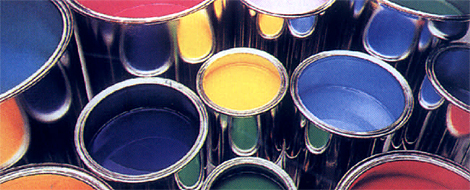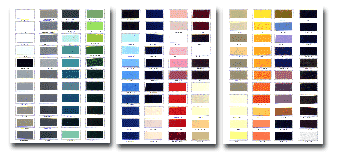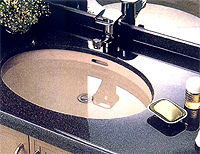|
Our Products
WPCP
Polyester Pigments
These are
dispersions of inorganic and organic compounds in a special grade of
unsaturated polyester resin vehicle, which cross links during curing with
commercial grades of Gelcoat and GP resin systems.
Opaque and
Translucent Pigments are two varieties in this range.

Pigment Usage Levels
The following is
the recommended usage level of WPCP Pigments with commercial grades of
molding resins. The percentage levels listed here is based on the weight of
the molding resin.
| |
7%-15% |
Gelcoats |
| |
3%-5% |
Laminates |
| |
8%-12% |
Sheet/Dough
Molding Compounds |
| |
0.5%-3% |
Translucent
Pigments Usage |
| |
3%-8% |
Filled
Castings |
| |
8%-10% |
Pultrusions |
Not using enough
pigments may lead to non-uniformity of color and other surface defects.
Higher pigmentation levels will provide better color uniformity, color
depth, brightness and longer durability.
Mixing Instructions
WPCP Pigments mix
readily with commercial polyester and epoxy resin systems. Small quantities
of pigments can be mixed easily by hand stirring. However, for large
quantities of pigment, power mixing is necessary. The following guideline is
helpful for mixing WPCP Pigments with resins:
|
1. |
Add
a weighed quantity of the pigment into a mixing container, followed by a
small amount of the resin. |
|
|
2. |
The contents are mixed well until the color is
uniform. |
|
|
3. |
This
is followed by adding the remainder of the resin, with further mixing,
until the system is homogeneous in color. |
|
Catalyst and Accelerator
Addition
The catalyst for
curing the pigmented resin should be added as per the instructions of the
original manufacturer of the resin. As a general working rule the catalyst
should be added to the pigmented resin just before actual usage.
Storage Stability
WPCP Pigments
have excellent stability in storage and the minimum guaranteed shelf-life is
24 months. Storage below 25 Celsius is recommended for longer shelf life.

Color Matching
WPCP Pigments can
be mixed with one another to obtain intermediate shades. Dark shades present
no particular color matching problems, but light shades may pose some
difficulty. WPCP uses the latest state-of-the art color matching computer
software and tools. Colors can be custom matched to customer's requirements,
provided the minimum quantity is over 250 Kilograms.
Contact
[email protected] for sales or
technical assistance on our Polyester Pigment products.
Color Chart
View over 132 colors online.

(Click on the colors above to enlarge)
You can download our catalog in PDF Format [Page
1, Page 2,
Page 3]
Literature and Links
1.
WPCP Pigments
- Product Profile
2.
WPCP Pigments - SDS
Value Proposition
Premium
Pigments: Quality inorganic and organic pigments from ISO certified
companies, conforming to the Color Index (C.I.) standards, are used in the
formulation of the dispersion.
Compatibility:
This base vehicle offers excellent compatibility with commercial grades of
polyester resin.
Superior Cross
Linking: The unsaturated pigment grade resin in our Polyester Pigments
cross links during curing and provides better structural properties to the
composite.
Flexibility:
The chain length of the pigment grade resin is designed to provide
flexibility in the polymer, thereby preventing surface brittleness of the
finished composite.
Micron
Particles: The pigment particles are processed to attain a particle size
below 5 microns.
Dispersion
Stability: The particles are dispersed and stabilized using specially
formulated surface active agents, using science based on the DLVO concept.
Maximum
Loading and Hiding Power: Our formulations contain the maximum loading
of dry inorganic and organic colors in the pigment dispersion, thereby
giving maximum coverage and hiding power.
Color
Uniformity: Provides a uniform surface coloration and streak-free
appearance in the finished composite.
Color
Consistency: Computerized color analysis laboratory using
spectrophotometers enables color consistency between batches.
ISO Procedures:
Processing is done follow ISO 9002 quality systems, ensuring optimium quality
control.


Product Applications
WPCP Pigments
have been widely used since 1998 in manufacturing processes such as Hand
Lay-Up, Spray Lay-Up, SMC, DMC, Pultrusion, Filament Winding, Vacuum
Bagging, RTM, and RFI. It has served to color the products of numerous
industry segments.
Building
Industry - Structural frames and bridges, doors and windows, flooring
and tiles, table top laminates, bathtubs and jacuzzi, bathroom accessories
and fittings, roof sheets, ladders, fences, mobile dwellings, portable
toilets, and water tanks.
Marine Industry - Boats and ship construction, decks, and masts.
Aerospace and
Automotive - Aircraft bodies and structural frames, wings, helicopter
blades, space equipment, rocket bodies, missile housing, car bodies,
fenders, and canopies.
Sports -
Surf boards, skis, protective gear and helmets, fishing rods, goal posts,
and flag masts.
Medical -
Prosthetics (artificial limbs)
Chemical
Industry - Process plant equipment, pressure vessels and containers,
tanks, cooling towers.
Electrical
Industry - Switch boxes, electrical housings, and electric poles.
Recreational - Amusement park facades and equipment, roof lights,
sculptures, specialty furniture, and architectural items.


Superior Performance
Light Fastness:
WPCP Pigments exhibit excellent light fastness and will not fade or discolor
on exposure to sunlight.
UV Resistance:
Ultraviolet (UV) radiation, from sunlight, accelerates the chemical and
physical degradation of FRP moldings exposed to outdoor conditions. The
degradation occurs mostly on the surface of the molding. But once degraded,
the surface tends to chalk and erode due to weathering, exposing fresh
surface to further attack. Protection of outdoor structures fabricated in
FRP is, therefore, important. WPCP Pigments absorb and convert UV radiation
into heat, which is dissipated to the surrounding medium readily. Therefore,
pigments prolong the outdoor service life of composite moldings. Protection
by this mechanism depends on the pigment concentration on the surface. Gel
coats having higher pigment loading will, therefore, afford longer
protection.
Outdoor
Durability: The durability of the WPCP Pigments depend on environmental
conditions such as heat, light, moisture, and industrial pollutants present
in the atmosphere. Generally the darker shades will have better durability
when exposed to outdoor conditions.
Heat
Resistance: FRP moldings manufactured using dough/sheet molding
compounds are usually processes at elevated temperatures of 140 0C to 160
0C, or higher. The heat resistance of the pigments in such applications
depend on exposure time, temperature, oxidizing conditions during
processing, heat transfer coefficients, and heat transport rates. We supply
special polyester pigments for coloring these moldings.
Chemical
Resistance: The compatibility of pigments to chemicals depends on the
material constitution of the pigments themselves. As a general rule
chemicals that would react with polyester resins would be incompatible with
the pigments. Our technical staff would be able to assist you in
recommending the available choice of colors for your applications.
Electrical
Properties: Polyester moldings are used to a large extent in electrical
applications. Special WPCP Pigments can be offered which will have no
adverse effects on track resistance, surface resistivity, dielectric
strength and other insulation properties.
Toxicity:
The toxicity of Pigments depends on the raw materials used in the
formulation. We can recommend a choice of pigments depending on your
requirements.


"WPCP - Your
Right Solutions"
|